mytest
Books etc. by ARUDOU Debito (click on icon):
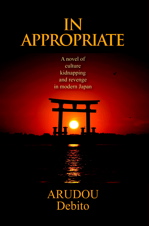
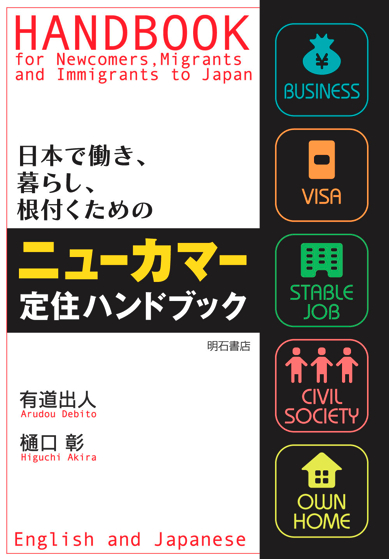


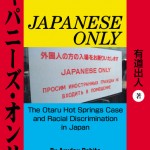
![]()

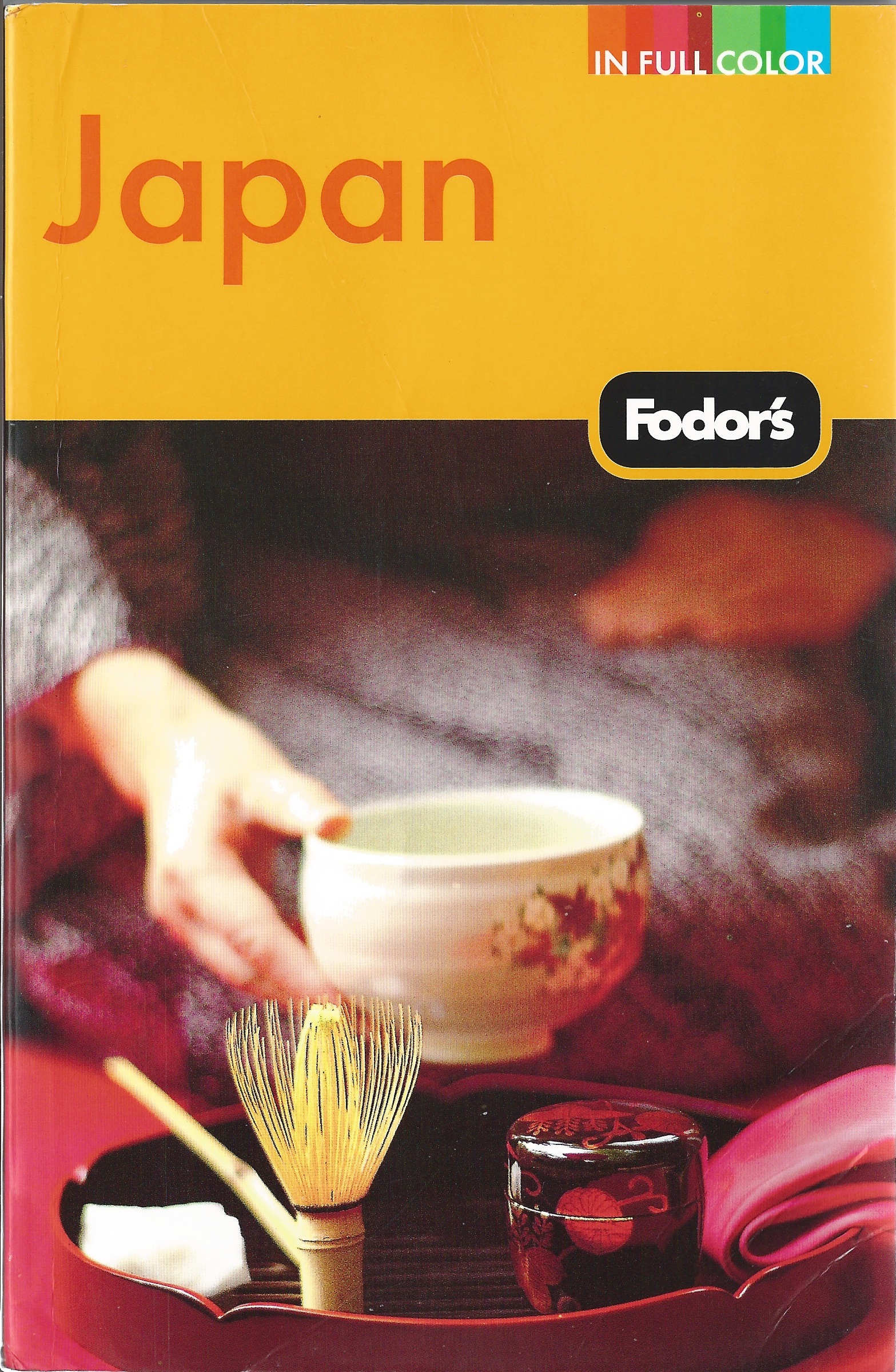
UPDATES ON TWITTER: arudoudebito
DEBITO.ORG PODCASTS on iTunes, subscribe free
Hi Blog. Following up on my blog post of June 10: “GOJ embryonic policymaking reboot for “co-existence with foreigners”: Some good stuff, but once again, policy about NJ without any input from them“, here is an evaluation of the GOJ’s third meeting of June 15, 2012. It’s taken a while to report on this since The Cabinet took their time putting the meeting’s materials online, but here is the cover page for proceedings, courtesy of http://www.cas.go.jp/jp/seisaku/kyousei/dai3/sidai.html
(click to expand image)
Once again, let’s walk through the materials provided. First up, the people (the yuushikisha “people of awareness” experts, presenting their views to the GOJ. Here are the links:
|
1.開会
|
||
|
2.中川大臣挨拶
|
||
|
3.議事
|
||
|
外国人が生活する「現場」での課題、取組について
|
||
|
(有識者からのヒアリング)
|
||
|
||
|
4.閉会
|
||
|
【配付資料】
|
||
| 資料1 | 鈴木氏提出資料 | |
| 資料2 | 中山氏提出資料 | |
| 資料3 | 田村氏提出資料 | |
| 資料4 | 坂本氏提出資料 | |
| 参考資料1 | 第2回検討会議(6月1日)における主な発言 | |
| 参考資料2 | 「外国人との共生社会」実現検討会議の開催について(要綱) | |
| 参考資料3 | 当面の検討会議スケジュール | |
| 参考資料4 | 有識者ヒアリング参集者 | |
| 参考資料5 | 外国人との共生社会の実現に向けた主な論点、検討課題(例) | |
As noted in my June 10 post, these are the backgrounds of the presenters:
Mr Suzuki Yasutomo is Mayor of Hamamatsu City, Shizuoka Prefecture (since so many NJ are clustered there working in factories; here’s his “manifesto” linked, with emphases on NJ children’s education, proper communication between Hamamatsu gaikokujin shimin (thank you) and the regular sort, and facilities). Ms Nakayama Hiroko is the Kuchou of Tokyo Shinjuku-ku (where the famed “a lawless zone of foreign crime” Kabukicho is; however, here’s her very well organized and readable “manifesto” for the next four years, which has decent mentions of, yes, “multicultural coexistence” and some proposals to back them up (see policies 51-53)). Mr Tamura Taro is representative of the Multicultural Center Osaka (which works a lot with Nikkei Brazilian issues). Ms Sakamoto Kumiko is head of NPO Aidensha (which works with Portuguese speakers etc. in Mie Prefecture explaining Japan’s rules, helping them get homes and proper insurances, and assisting in translations etc.). They all seem informed and on the level, albeit there is weighting towards dealing with Nikkeis rather than just NJs. Now let’s look at what they presented to the GOJ:
ITEM ONE: Hamamatsu Mayor Suzuki’s powerpoint:
Mayor Suzuki opens with an overview of the major changes in the makeup of NJ since 1990, with the doubling of the NJ population and then the drop after the “Lehman Shock” and Fukushima. Particularly noted was the drop in their (local) Brazilian population (which makes the GOJ’s focus on Nikkei NJ all that more puzzling, given the absence of the Chinese and Filipinas/nos, as the other top NJ (and growing, unlike the Brazilians) at this forum). Suzuki makes the salient point that cities around Hamamatsu have been cooperating for more than a decade now to create policies helping their NJ residents (e.g., The Hamamatsu Sengen, up to now studiously ignored by the GOJ). He gives the demographics of his NJ, particularly how long they’ve been here (nearly half for more than 15 years [!]), and that nearly half of them have Permanent Residency (and 83% have long-term visas). He talks inter alia about Hamamatsu’s measures taken (e.g., Japanese language teaching, in which 89% of teachers are “volunteers” not assisted by the GOJ), and laments that there is no compulsory education for NJ children guaranteed by law [!!]. He also talks about the “lack” (ketsujo, the same word used when decrying a lack of common sense) of unified policy or promotion on the part of the GOJ (particularly singling out the Cabinet for treating NJ as “a laborer problem” and over-focusing on Nikkei [!!!] concerns), and an overall “lack of aim to accept NJ” (gaikokujin no uke ire houshin no ketsujo). He proposes a) that a joint integrated social policy be created and promoted at the national level; b) that teijuu (Long-Term Residency, a quasi-PR visa hitherto reserved for the Nikkei Brazilians and Peruvians) policies be expanded to all NJ; c) that a “NJ Bureau” (kyoku) be created in the short term, a “NJ Agency” (gaikokujin chou) be created in the medium term; d) that this “coexistence” series of meetings be made continuous; e) that a research council be established with more yuushikisha and people who have experience in education (gakushoku keikensha), and f) that a non-partisan politician group be created within the Diet to debate more on how to accept (uke ire) NJ. [!!!!]
(COMMENT: Wow. Let me just interject bowdlerized Hendrix here: “Excuse me, while I kiss this guy!”)
ITEM TWO: Shinjuku-ku Head Nakayama’s powerpoint:
Ms. Nakayama opens with a view “from the field” (genba de) of how NJ live their lives (I guess that’s somehow better than having NJ actually there at the meeting). Her 14-page but very readable powerpoint goes through the statistics of the NJ under her mandate: 11% of all residents (appropriately now worded as juumin) are NJ, with the top three quarters (37% each) Koreans and Chinese; fewer PRs than the national average (far more people, particularly close to half of all the Chinese, are there on “student” visas (ryuugaku; shuugaku) due to the local J language schools and Waseda), along with a jump (more than doubling) in the number of PRs; a quarter of all NJs live in the (traditionally Korean district) of Ohkubo, and a fifth are young, in their twenties. Interesting stats, but…. Just when you think this presentation will end as a show-and-tell, we get a few slides on Shinjuku-ku’s attempts at multicultural coexistence policies: Japanese language training (taught again by volunteers) at their Tabunka Kyousei Plaza, with a paid course (1500-4000 yen per semester) once or twice a week in ten locations, and a multilingual “consultation corner” in English, Korean, Chinese, Burmese, and Thai. There is some Japanese language teaching for Grade and Jr. High schoolers both at the Ku-level and at some Ku-ritsu schools. There some “guidelines” handbooks for life and disaster prevention in Korean, Chinese, English, and Japanese, and finally rah-rah the end of the presentation, where she says that we at the local level are doing lotsa stuff to help people, but there’s a limit to what they can do: We have to come up with a unified philosophy (ri’nen) for how we’re going to systematize social welfare, employment, education, children’s upbringing, and lifestyles for NJ, etc., etc. There were no grounded proposals beyond that, making Ms Nakayama’s presentation a definite anticlimax to Mayor Suzuki’s suggestions. In the end, this felt like a bureaucratic presentation justifying budgets.
ITEM THREE: Multicultural Center Osaka Head Tamura’s powerpoint:
Tamura also opens with the “genba de” view (sorry, must just be the title they were given by the bureaucrats, but Suzuki above shirked it), first introducing his NPO and what it does (promoting daibaashiti; okay, that sounds better to me than the hackneyed and misunderstandable “coexistence”) though its five centers nationwide. Tamura was deeply involved in the volunteer efforts for relief and recovery in Tohoku area over the past year. Comes off as a good egg. Then he gets to his points about NJ residents: He pointed out three “weak spots” (3 tsu no zeijaku sei) in how NJ live their lives as J residents: 1) a language and customs barrier (i.e., lack of instruction and access to policy), 2) legal recourse (little to no translation systems or personnel, or guaranteed access to education or boards of education), and 3) misunderstandings and prejudices on the part of Japanese society (e.g., “Hey, they came here of their own accord so they can fend for themselves”, or “the increase in NJ threatens our public safety”). This results in their being excluded from education, employment, accommodation, and welfare. NJ should not be seen as “weak” in themselves, but rather as in a weakened position in society. He advocates inter alia that 1) NJ be seen by society not as “temporary stayers” but as “permanent citizens” (eijuu suru shimin — with an effective chart comparing the rise of PR Newcomers over the PR Oldcomers on page 4); 2) gentle and sophisticated (teinei) policies for coexistence be created reflecting the diversity in NJ based upon their specific areas of residence (with four sophisticated models proposed for a) major cities, b) places with high NJ populations, c) suburbs, and d) provinces, quite specific in detail; page 5); 3) four groupings for dealing with the major parties to this issue — the local governments, the national government, the local Japanese residents and industry, and — yes — the NJ communities (finally, an acknowledgment of a sense of domestic ethnic community without it being construed as a threat to Japan); again, quite detailed on page 6); 4) consider the future Japan with one million NJ PRs (nearly at that point already), and what should be done about it — inter alia: a) consultations with NPOs and local governments, b) not seeing problems as specifically “foreign problems”, c) public acknowledging the good that NJ do for Japanese society, d) social workers that include NJ residents, and e) laws to back up any policies. [!!!!!] Very, very good stuff indeed!
ITEM FOUR: NPO Aidensha Head Sakamoto’s powerpoint:
Sakamoto gave a very thick and academic series of essays that probably put the bureaucrats to sleep, opening with an organizational chart of how NPOs and NGOs relate to society at large in their activities. She gave an over-detailed laundry list of the activities her NGO has carried out (including how find free computer courses and how to register e-messages; filter, Ms. Sakamoto!). Amidst some very meaningful jobs Aidensha does (e.g., assisting people out of DV situations, finding housing, assisting with visa and social insurance issues, etc.) was the overwhelming chaff of giving case studies and telling stories about their hard work, when all the audience merely wanted was conclusions and advice. Her points, when filtered of chaff, useless stats, and photographs were inter a lot of alia, 1) helping non-native speakers of Japanese get around and fend for themselves, 2) educating NJ children, 3) resolving employment and unemployment problems, 4) finding stable lives and residences, and, er… f) we should be nice and respectful to one another. When we get into what I call “Kumbaya Territory”, you lose the bureaucrats. I hope somebody patted her on the back for all her hard work, since that’s what it seemed like she wanted.
The other five items at the links above were recap: Items 1) and 2) were the Minutes and Attendees from the previous meetings (which I covered in my blog entry here), 3) was the schedule of meetings previous and future (the next one will be July 3, with more yuushikisha, and the fifth one will be at a later date and feature interim thoughts on what concrete policies to pursue). Item 4 tells us who are the scheduled yuushikisha for the July 3 meeting (including — gasp! — an actual NJ, or rather, former NJ, naturalized former Brazilian Angelo Ishi of Musashi University, along with three other regular Japanese academics from Tsukuba, Keio, and Dokkyou Universities). The final Item 5 was a summary of the points under consideration so far regarding realizing a “Coexistence Society with Foreigners” all over again. The problems listed therein were also recaps of ones covered in my previous blog entry.
COMMENT: Alright, this is a positive series of developments, with inputs much better than the first two meetings (it’s a pity the short-sighted bureaucrats almost always get first dibs on agenda setting, with the people who might offer different opinions, such as Angelo Ishi, thrown in later down the line as an afterthought. Nevertheless, it’s a good Third Act in this political theatre, where people who contributed to the June 15 Meeting have made their points, two of them saying things I would have said (down to the semantics). Good. Still, however, no mention of that law against racial discrimination…
More on the July 3 Meeting when it goes online no doubt in a few weeks. Thanks for reading. Arudou Debito
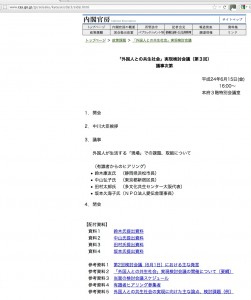
12 comments on “GOJ Cabinet “Coexistence with NJ” Pt. 2: Critique of June 15, 2012 meeting — a very positive Third Act to this Political Theatre”
Hi,
Very interesting reading. I look forward to reading about the next meeting.
That use of “coexistence” bothers me like other phrases such as “it is regrettable”… “it cannot be helped”. It leaves me disheartened.
Thank you.
John
Reading information like this give me a lot of hope for the future. Not just in the idea of policy change, since it probably won’t amount to much.
But, hearing these Japanese beaurocrats actually make well thought out, well founded suggestions and arguments FOR NJ brings a little smile to my face.
Wow, really great stuff in here!
But I agree with John, hearing “coexistence” disheartens me. I think the coexistence rhetoric is going to be used to deny the possibility of assimilation into Japanese society of NJ, and like so much else is well-intentioned but ultimately discriminatory. So while I appreciate the efforts these people are undertaking for NJ rights, I am wary because
1) like you said, there is still no direct representation from NJ at these hearings
2) “coexistence” can just as easily mean “you’re fundamentally different and can never be like us, but we might as well live together”
Anyway, thanks for posting the info.
Debito:
As a question,
have such local initiatives occurred in the past history?
If so, what were their results?
— Sorry, don’t understand the question. What do you mean by “such local initiatives”? I’ve already provided a link to the Hamamatsu Sengen.
Sorry, I was unclear.
Have there been other such initiatives, besides those that you provide in this posting?
For example, there have been many NJ in Okinawa; have there been any such initiatives there?
I am trying to see what the face has been in the past of any such initiatives, and what the likely fate of this will be.
Has anyone spoken to those who made such presentations?
It would be interesting to know their thoughts on what they think is likely to occur in the future.
Well, I’m not trying to be a downer, but I have heard platitudes from policy makers so many times that I will believe this when I see how it is implemented.
I remember many years ago as a post-grad student interviewing a senior public worker in Kobe City Hall about Kobe’s (apparently) ‘international’ image amongst the Japanese. He talked for about ten minutes about how Kobe has lots of foreign restaurants, and foreign ‘brands’, and lots of foreign tourists. That was it. That was what ‘internationalization’ meant to him; buying non-Japanese things.
this meeting was a joke to begin with because how can they make important decisions that affect NJ when not one NJ was present during the meeting?
and this meeting is a sham because they forgot to mention anti discrimination against NJ. And why didn’t they even admit that they need a LAW to stop discrimination against NJ? If Korea can do it 5 years ago then why cant Japan????
@ Jim #7
Well, I guess it would be ok not to have ‘just’ any NJ, but I can’t understand why they can’t include at least a token NJ Japanese citizen like Debito. I guess that Donald Keene is still off on his cruise, helping Tohoku, so they were at a loss…..
@ Jim #8
Why can Korea do it but Japan can’t?
A long time J-friend of mine who was schooled outside of Japan actually looked me straight in the eye on Monday and told me ‘there is no racism in Japan’. I was shocked, because he is such an atypical Japanese. He worked at a big US company for years before becoming the president of a Japanese company with international concerns. Yet, I believe that he honestly believes what he said is true. So I concluded either;
1. He is not aware of the problems faced by NJ. Or…
2. He is aware of the problems faced by NJ in Japan, but believes that that is the appropriate way NJ should be treated. That is to say that NJ are not discriminated against, but rather that the treatment they receive is fair (considering that they are not Japanese).
I am leaning towards the opinion that whilst a great number of Japanese would likely agree with NJ against discrimination IOF they were made aware of the issues, that the unfortunate fact is that the greater percentage of Japanese think that is absolutely natural and proper that NJ are treated as second class citizens.
Jim DiGriz #9
Regarding your long-time J friend, it does stagger my imagination.
The novelist Shimazaki Toson wrote about discrimination in his novel a century ago (against the buraku people).
And J tell me that discrimination against buraku is still widespread and commonly known.
I tend to think that J may be like Saudis, who practice a stratified form of discrimination with various types of people being less and less worthy of consideration as deserving any rights whatsoever.
Saudis view it as entirely natural, just as Westerners view humans as deserving of more rights than dogs, which merit greater rights than beetles.
In other words, if racism is defined as undeserved ill-treatment rather than as ill-treatment, then the perspective is entirely understandable.
Many J view the ill-treatment of NJ as merited, just as one can treat a dog more harshly than a child.
It’s good for NJ to know that Japanese panelists who participated in this meeting do really understand the problems and put their utmost commitment to help them out from the bottom of the heart. Regarding the legal framework, I don’t believe the Cabinet minister will let anyone speak about the existence of racial discrimination or the legal framework against its practice, per se. To me, they seem to consider the meeting as the place for the opportunities to share information (情報共有)and exchange opinions(意見交換). Superficial,as always.
@Jim Di Griz #9
“A long time J-friend of mine who was schooled outside of Japan actually looked me straight in the eye on Monday and told me ‘there is no racism in Japan’.”
“the greater percentage of Japanese think that is absolutely natural and proper that NJ are treated as second class citizens.”
Exactly.
When told of obviously racially discriminatory practices in Japan, most Japanese I’ve spoken with reply with this mind-blower, “それは「人種差別」じゃない、それはただの普通な区別です。”
“That’s not ‘racial discrimination’, that’s just perfectly acceptable differentiation.”
They know the word ”discrimination 差別” is sullied, yet they think the word “differentiation 区別” is fine.
They literally have said, “It’s perfectly fine to practice differently based on race, but that’s not ‘racial discrimination.’”
Just last week I spoke with a City Office Manager forcing all 「外(国)人」 recipients of 子供手当 to show extra “proof” that 「日本人」 recipients didn’t have to show.
I spoke with him for about an hour. His non-changing reasoning was his suspicion that a higher percent of 「外(国)人」 illegally go spend the 子供手当 abroad, and that Japanese people don’t do this illegal thing much, so this nationality-based-differentiation区別 is acceptable.
This nationality-based-differentiation区別 quickly becomes race-based-discrimination, since his section uses their eyes to scan and determine which recipients they demand show this extra proof, since his section doesn’t know have nationality information available to them. For example, when people like me use I.D. like my 国民健康保険 card with my name written only in Kanji (no Katakana, no Romaji) this manager and his staff use my skin color to begin their demands for extra proof of law-abiding-ness.
He even authored an official mailing, sent to every resident of the town I live in (population about 120,000) that if the householder is a 外国人 he/she must show the passports of HIS/HER ENTIRE FAMILY, or else he/she won’t receive 子供手当.
No matter how much I told him this whole practice is 国籍差別 at best and 人種差別 at worst, he proudly maintained, ”いいえ、そんなことありません、これは区別です。” The pride in his defense was obvious, “Treating 日本人 recipients and 外人 recipients differently is perfectly acceptable, this is simply 区別 = differentiation.”